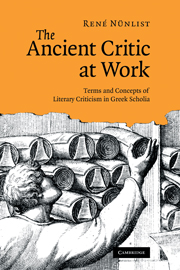Book contents
- Frontmatter
- Contents
- Acknowledgments
- Introduction
- PART I
- PART II
- 13 The gods in Homer
- 14 Homeric similes
- 15 Epithets
- 16 Type scenes
- 17 Homeric speeches
- 18 Reverse order
- 19 Staging, performance and dramaturgy
- Epilogue
- Glossary of Greek terms
- Editions of scholia
- Other abbreviations
- Bibliography
- Thematic index
- Index locorum
16 - Type scenes
Published online by Cambridge University Press: 29 August 2009
- Frontmatter
- Contents
- Acknowledgments
- Introduction
- PART I
- PART II
- 13 The gods in Homer
- 14 Homeric similes
- 15 Epithets
- 16 Type scenes
- 17 Homeric speeches
- 18 Reverse order
- 19 Staging, performance and dramaturgy
- Epilogue
- Glossary of Greek terms
- Editions of scholia
- Other abbreviations
- Bibliography
- Thematic index
- Index locorum
Summary
Ancient scholars do not seem to have been aware of the oral nature of Homeric epic (see also Chapter 15), but they did recognise the recurrent pattern of particular Homeric scenes, as the present chapter will show. Thus their approach is similar to Arend's in his seminal study Die typischen Scenen bei Homer (1933), who neither knew of Parry's results nor drew a corresponding conclusion himself. Unlike Arend, the scholia do not make use of a particular term for ‘type scene’.
ARMING
The type scene which receives the most attention in the Homeric scholia is the arming scene (ὁπλισμός). The impulse seems to come from Zenodotus' treatment of Paris' arming before his duel with Menelaus in Iliad 3, as explained by Aristonicus:
ὅτι Ζηνόδοτος ἀμϕοτέρους ἠθέτηκεν, καὶ μετὰ τὸν “οἷο κασιγνήτοιο” [Il. 3.333] ὑποτάσσει
“κρατὶ δ᾽ ἐπ᾽ ἰϕθίμῳ κυνέην εὔτυκτον ἔθηκεν
ἵππουριν· δεινὸν δὲ λόϕος καθύπερθεν ἔνευεν·
ἀμϕὶ δ᾽ ἄρ᾽ ὤμοισιν βάλετ᾽ ἀσπίδα τερσανόεσσαν
εἵλετο δ ᾽ἄλκιμον ἔγχος,” [3.336–7, ≈ 334, 338]
ὥστε ἐναντίως τῷ ῾Ομηρικῷ ὁπλισμῷ [cf. 11.19–42, 15.479–81] ἔχειν· πρὸ τῆς ἀσπίδος γὰρ ϕανήσεται ἀναλαμβάνων τὴν περικεϕαλαίαν καὶ ξίϕος μὴ ἔχων.
(schol. A Il. 3.334–5a Ariston.)<The diplai periestigmenai,> because Zenodotus omits both <lines> [sc. 3.334–5], and after the <line beginning with> ‘of his brother’ [3.333] he attaches ‘On his powerful head he [sc. Paris] set the well-fashioned helmet with the horse-hair crest, and the plumes nodded terribly above it. Across his shoulders he slung the [??] shield. He took up a strong-shafted spear', so that there is a contradiction with the Homeric arming. For [sc. with Zenodotus' text] he will be seen taking up the helmet before the shield and not having a sword.
- Type
- Chapter
- Information
- The Ancient Critic at WorkTerms and Concepts of Literary Criticism in Greek Scholia, pp. 307 - 315Publisher: Cambridge University PressPrint publication year: 2009



